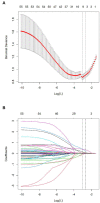Nomogram to predict 6-month mortality in acute ischemic stroke patients treated with endovascular treatment
- PMID: 38249750
- PMCID: PMC10796830
- DOI: 10.3389/fneur.2023.1330959
Nomogram to predict 6-month mortality in acute ischemic stroke patients treated with endovascular treatment
Abstract
Background: Acute Ischemic Stroke (AIS) presents significant challenges in evaluating the effectiveness of Endovascular Treatment (EVT). This study develops a novel prognostic model to predict 6-month mortality post-EVT, aiding in identifying patients likely to benefit less from this intervention, thus enhancing therapeutic decision-making.
Methods: We employed a cohort of AIS patients from Shenyang First People's Hospital, serving as the Validation set, to develop our model. LASSO regression was used for feature selection, followed by logistic regression to create a prognostic nomogram for predicting 6-month mortality post-EVT. The model's performance was validated using a dataset from PLA Northern Theater Command General Hospital, assessing discriminative ability (C-index), calibration (calibration plot), and clinical utility (decision curve analysis). Statistical significance was set at p < 0.05.
Results: The development cohort consisted of 219 patients. Six key predictors of 6-month mortality were identified: "Lack of Exercise" (OR, 4.792; 95% CI, 1.731-13.269), "Initial TICI Score 1" (OR, 1.334; 95% CI, 0.628-2.836), "MRS Score 5" (OR, 1.688; 95% CI, 0.754-3.78), "Neutrophil Percentage" (OR, 1.08; 95% CI, 1.042-1.121), "Onset Blood Sugar" (OR, 1.119; 95% CI, 1.007-1.245), and "Onset NIHSS Score" (OR, 1.074; 95% CI, 1.029-1.121). The nomogram demonstrated a high predictive capability with a C-index of 0.872 (95% CI, 0.830-0.911) in the development set and 0.830 (95% CI, 0.726-0.920) in the validation set.
Conclusion: Our nomogram, incorporating factors such as Lack of Exercise, Initial TICI Score 1, MRS Score 5, Neutrophil Percentage, Onset Blood Sugar, and Onset NIHSS Score, provides a valuable tool for predicting 6-month mortality in AIS patients post-EVT. It offers potential to refine early clinical decision-making and optimize patient outcomes, reflecting a shift toward more individualized patient care.
Keywords: endovascular treatment; ischemic stroke; mortality; nomogram; prediction.
Copyright © 2024 Wen, Wang, Bian, Zhu, Xiao, He, Wang, Liu, Shi, Hong and Xu.
Conflict of interest statement
The authors declare that the research was conducted in the absence of any commercial or financial relationships that could be construed as a potential conflict of interest. The reviewer ZL declared a shared affiliation with the author RW to the handling editor at the time of review.
Figures






Similar articles
-
Construction and validation of a predictive model for poor long-term prognosis in severe acute ischemic stroke after endovascular treatment based on LASSO regression.Front Neurol. 2025 Apr 14;16:1535679. doi: 10.3389/fneur.2025.1535679. eCollection 2025. Front Neurol. 2025. PMID: 40297852 Free PMC article.
-
Construction and validation of a nomogram for predicting 3-month outcome in elderly patients with nonvalvular atrial fibrillation-induced acute ischemic stroke.Front Neurol. 2025 May 9;16:1561446. doi: 10.3389/fneur.2025.1561446. eCollection 2025. Front Neurol. 2025. PMID: 40417121 Free PMC article.
-
Clinical scoring model based on age, NIHSS, and stroke-history predicts outcome 3 months after acute ischemic stroke.Front Neurol. 2022 Aug 5;13:935150. doi: 10.3389/fneur.2022.935150. eCollection 2022. Front Neurol. 2022. PMID: 35989904 Free PMC article.
-
Nomogram-Based Prediction of the Futile Recanalization Risk Among Acute Ischemic Stroke Patients Before and After Endovascular Therapy: A Retrospective Study.Neuropsychiatr Dis Treat. 2023 Apr 13;19:879-894. doi: 10.2147/NDT.S400463. eCollection 2023. Neuropsychiatr Dis Treat. 2023. PMID: 37077709 Free PMC article.
-
Endovascular Therapy for Stroke Presenting Beyond 24 Hours: A Systematic Review and Meta-analysis.JAMA Netw Open. 2023 May 1;6(5):e2311768. doi: 10.1001/jamanetworkopen.2023.11768. JAMA Netw Open. 2023. PMID: 37140919 Free PMC article.
Cited by
-
Association between stress hyperglycemia ratio (SHR) and long-term mortality in patients with ischemic stroke: a retrospective cohort study.Cardiovasc Diabetol. 2025 Apr 25;24(1):180. doi: 10.1186/s12933-025-02730-8. Cardiovasc Diabetol. 2025. PMID: 40281588 Free PMC article.
-
SMART-M24: A Prognostic Nomogram for Long-Term Mortality in Acute Ischemic Stroke Beyond 24 H from Symptom Onset.Transl Stroke Res. 2025 Jun 9. doi: 10.1007/s12975-025-01361-1. Online ahead of print. Transl Stroke Res. 2025. PMID: 40488807
-
Construction and validation of a predictive model for poor long-term prognosis in severe acute ischemic stroke after endovascular treatment based on LASSO regression.Front Neurol. 2025 Apr 14;16:1535679. doi: 10.3389/fneur.2025.1535679. eCollection 2025. Front Neurol. 2025. PMID: 40297852 Free PMC article.
-
Development and Empirical Study of a Lower Extremity Deep Vein Thrombosis Prevention Protocol for Patients Undergoing Gynecologic Laparoscopic Surgery.Clin Appl Thromb Hemost. 2025 Jan-Dec;31:10760296251367721. doi: 10.1177/10760296251367721. Epub 2025 Aug 25. Clin Appl Thromb Hemost. 2025. PMID: 40853176 Free PMC article.
References
LinkOut - more resources
Full Text Sources

